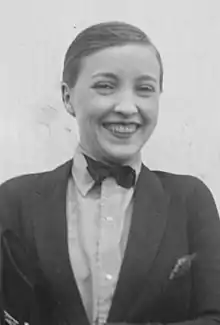
The Eton crop is a type of very short, slicked-down crop hairstyle for women.[1]
Popularity
It became popular during the 1920s because it was ideal to showcase the shape of cloche hats.[1] It was worn by Josephine Baker, among others.[1] The name derives from its similarity to a hairstyle allegedly popular with schoolboys at Eton.[2]
History
The Eton crop appears to have emerged in Britain in the mid-1920s: the first use of the phrase in The Times is in September 1926.
Description
It was a severe hairstyle, emphasising the shape of the head and focusing interest on the face. By June 1927 Margot Asquith, Lady Oxford, was deriding it: "Women with neither backs nor tops to their heads, and faces as large as hams, appear at the King's Drawing Rooms with the nuque of their necks blue from shaving...".[3] By 1930 it seems to have become outmoded among the most fashionable.
In culture
A critic reviewing a collection of society portraits notes: "Hairdressing is in a state of transition. There is an Eton crop, there are many soft shingles, and there are a few heads where the hair is being let grow."[4]
It was the haircut of choice for the more masculine lesbians in the lesbian subculture, particularly in England, during its time of popularity.[5]
See also
References
External links
- Caulton, Geoff. "Twenties Hairstyle - Eton Crop". Photo Detective.
British family photographs (1901-53)